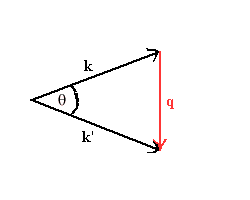
In a typical scattering experiment a target is struck by a beam of
mono-energetic particles.
Let Fi be the incident flux, i.e. the number of particles per
unit area per unit time.
Fi = npv,
where np is the number of particles per unit volume.
Typically np
is very small and we can neglect any interaction between different incident
particles.
We measure the number ΔNp of
particles scattered per unit time into a solid angle ΔΩ about the
direction defined by the spherical coordinates θ and φ.
We
expect ΔNp ∝ Fi,
and ΔNp ∝ ΔΩ .
We define ΔNp = σt(θ,φ)FiΔΩ.
Here σt(θ,φ) is
the differential scattering cross section of the target. It has the
units of an area. Commonly used units are cm2 and barn = 10-24 cm2.
Assume a central potential energy function of finite range, i.e. U(r) --> 0 as r -->
∞ faster than 1/r.
Then stationary state solutions
of the eigenvalue equation HΦk(r)
= EkΦk(r)
with the asymptotic form
Φk(r) = eikz + fk(θ)
eikr/r = ∑l=0∞ cl Pl(cosθ)
sin(kr - lп/2 + δl)/(kr)
exist. Here
fk(θ) = (1/k)∑l=0∞(2l+1)exp(iδl)sinδlPl(cosθ)
is the scattering amplitude, δl
is called the phase shift of the lth partial wave.
The differential scattering cross section is
σk(θ)
= dσk/dΩ
= |fk(θ)|2 = (1/k2)|∑l=0∞(2l+1)exp(iδl)sinδlPl(cosθ)|2,
and the total scattering cross section is
σk = ∫∫σk(θ)sinθdθdφ
= (4п/k2)∑l=0∞(2l+1)sin2δl.
Let R be the range of the potential. If kR << (l(l + 1))½, then
δl = 0.
Assume kR << (l(l + 1))½ for all l except l = 0. Then
fk(θ) = (1/k)exp(iδ0)sinδ0,
σk(θ)
= (1/k2)sin2δ0,
and σk = (4п/k2)sin2δ0.
This is called s-wave scattering.
[To derive the expression fk(θ)
= (1/k)∑l=0∞(2l+1)exp(iδl)sinδlPl(cosθ)
we expand Φk(r)
in terms of the common eigenfunctions of H, L2 and Lz, |klm>
= (u(r)/r)Ylm(θ,φ).
In classical mechanics, a free particle with angular momentum
L about the
origin and momentum p moves in a straight line with closest distance to
the origin b = L/p; b is called the impact parameter relative to the origin.
If L = ħ(l(l + 1))½ and p = ħk,
then bl(k) = (1/k)(l(l + 1))½.
bl(k) is the radius where the angular momentum barrier potential, Ueff(r) = l(l+1)ħ2/(2mr2) is
equal to the total energy of the free particle.
l(l+1)ħ2/(2m(bl(k))2)
= ħ2k2/(2m), bl(k)
= (1/k)(l(l + 1))½.
In Quantum Mechanics, for r < bl(k), in the classically forbidden
region, the eigenfunctions |klm> can only have an approximately exponentially
decaying tail.
In a finite range potential, if the partial wave with angular momentum quantum
number l only has an approximately exponentially decaying tail in the region
where the potential is non-zero, then it is minimally affected by the potential
and the phase shift
δl is approximately zero.]
For a finite range potential U(r) of range R the phase shift δ0 is negative if U(r)r<R > 0,
and it is positive if U(r)r<R < 0. If U(r)r<R =
∞ then δ0 = kR, σk
= 4пR2, if kR << 1.
For U(r)r<R < 0 we can have δ0
= п/2 while kR << 1, then σk
= 4п/k2 --> ∞ as
E --> 0. If δ0 =
п, then σk =
0. This is called the Ramsauer-Townsend effect.
The elastic scattering cross section in the Born Approximation is
σkB(θ,φ)
= σkB(k,k') = [μ2/(4п2ħ4)]|∫d3r'
exp(-iq∙r')U(r')|2,
where q = k' -
k,
k =
μv0/ħ,
k' = μv0/ħ
(k'/k'), and μ is the reduced mass.
The differential scattering cross section is proportional to the square of
the Fourier
transform of the potential.
We often want to know the scattering cross section as a function of the
scattering angle and not as a function of the momentum transfer. Let
θ be the angle between k and
k'. Then q
= 2ksin(θ/2).
